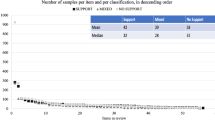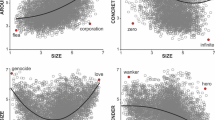Abstract
This paper explores the effect of manipulating the internal structure of a complex subject on the incidence of subject-verb agreement errors. Using the sentence completion task (Bock & Miller, 1991), this study followed up on Vigliocco and Nicol's (1995) finding that the syntactic distance between a head noun and a number-mismatching noun contained within a modifier has an impact on error incidence: the greater the distance, the lower the error rate. The study presented in this paper investigated whether this distance effect is purely syntactic; if so, then it would be expected that there would be fewer errors followingThe owner of the house which charmed the realtor... than followingThe owner of the house who charmed the realtors..., since in the latter, the mismatch is syntactically nearer the head noun. Results show no hint of a difference between the two, suggesting that the distance effect is more likely due totemporal distance rather than syntactic distance per se.
Similar content being viewed by others
References
Bock, J. K. (1986). Syntactic persistence in language production.Cognitive Psychology, 18, 355–387.
Bock, J. K., & Cutting, J. C. (1992). Regulating mental energy: Performance units in language production.Memory and Language, 31, 99–127.
Bock, J. K., & Eberhard, K. M. (1993). Meaning, sound, and syntax in English number agreement.Language and Cognitive Processes, 8, 57–99.
Bock, J. K., & Loebell, H. (1990). Framing sentences.Cognition, 35, 1–39.
Bock, J. K., & Miller, C. A. (1991). Broken agreement.Cognitive Psychology, 23, 45–93.
Branigan, H., Pickering, M. J., Liversedge, S. P., Stewart, A. J., & Urbach, T. P. (1995). Syntactic priming: Investigating the mental representation of language.Journal of Psycholinguistic Research, 24 (this issue).
Dell, G. S. (1986). A spreading activation theory of retrieval in sentence production.Psychological Review, 93, 283–321.
Eberhard, K. M. (1993).The specification of grammatical number in English. Unpublished doctoral dissertation, Michigan State University.
Fromkin, V. A. (1971). The non-anomalous nature of anomalous utterances.Language, 47, 27–52.
Garrett, M. F. (1976). Syntactic processes in sentence production. In R. Wales and E. Walker (Eds.),New approaches to language mechanisms. Amsterdam: North-Holland.
Stemberger, J. P. (1985). An interactive activation model of language production. In A. Ellis (Ed.),Progress in the psychology of language (pp. 143–186). London: Erlbaum.
Vigliocco, G., Butterworth, B., & Garrett, M. F. (in press). Cross-linguistic variability in subject-verb agreement errors.Cognition.
Vigliocco, G., Butterworth, B., & Semenza, C. (1995). Constructing subject-verb agreement in speech: The role of semantic and morphological factors.Journal of Memory and Language, 34, 186–215.
Vigliocco, G., & Nicol, J. (1995).The role of syntactic tree structure in the construction of subject-verb agreement. Manuscript submitted for publication.
Author information
Authors and Affiliations
Additional information
This research was supported by grant 5 P60 DC 01409-05, a Research and Training Grant funded by the National Institute on Deafness and Other Communicative Disorders, National Institutes of Health, to the National Center for Neurogenic Communication Disorders, University of Arizona. I am grateful to Danielle Cvitanovic, Nicole Diamond and Brad Greenwell for their assistance in testing subjects and scoring responses. I wish to thank Merrill Garrett for reviewing an earlier draft of this paper.
Rights and permissions
About this article
Cite this article
Nicol, J.L. Effects of clausal structure on subject-verb agreement errors. J Psycholinguist Res 24, 507–516 (1995). https://doi.org/10.1007/BF02143164
Accepted:
Issue Date:
DOI: https://doi.org/10.1007/BF02143164




